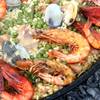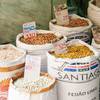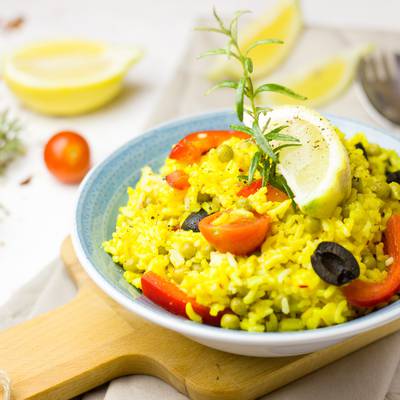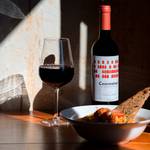General
Transport
People
Accomodation
Food & Drink
 What is local food like in Spain?
What is local food like in Spain?
 How much does the food cost?
How much does the food cost?
 What are some places to eat?
What are some places to eat?
 What can I eat in Spain as a vegetarian?
What can I eat in Spain as a vegetarian?
 Can I drink tap water in Spain?
Can I drink tap water in Spain?
 What soft drinks are available?
What soft drinks are available?
 Is there a coffee and tea culture in Spain?
Is there a coffee and tea culture in Spain?
 What alcoholic drinks to try while in Spain?
What alcoholic drinks to try while in Spain?
 What are the restrictions regarding alcohol consumption?
What are the restrictions regarding alcohol consumption?
 Where to buy alcohol in Spain and how much does it cost?
Where to buy alcohol in Spain and how much does it cost?
Sightseeing
Legal
Money
Safety & Health
Family travel

What local dishes to try in Spain?
Paella. One of the most traditional and famous rice dishes in Spain, paella comes in several varieties, but if you can, try Valencia paella. Valencia is the region in which this dish originates so you’d better believe they know how to make this highly-sought after Spanish food just right. The most traditional variations are made with rabbit, chicken or seafood. The meat or seafood is simmered together with green beans, white beans, rice, and herbs like saffron and rosemary. It may take some time to prepare, but the slow cooking process highlights the distinctive flavors. You’ll easily be able to spot paella in restaurants by the bright yellow rice, which takes its color from the saffron.
Gazpacho. Best described as a cold tomato soup, this definition doesn’t really do gazpacho justice. You have to try it to find out why a seemingly simple dish is such a tasty favorite for so many people. A proper gazpacho is made from only fresh tomatoes, cucumber, red bell peppers, garlic, bread, and olive oil blended together into a smooth, refreshing liquid.
Jamón. One of the most famous Spanish foods and one that Spanish people go absolutely nuts for, jamón is a cured ham made from either mountain pig or black Iberian pig, the latter of the two being more expensive. The legs from these pigs are salted and hung to dry in order to preserve them to be consumed throughout the long winter. Nowadays, jamón is commonly served as an appetizer on its own, or with bread. The paper-thin slices allow diners to enjoy the salty, savory flavor in small yet satisfying doses. Spanish people consider jamón a staple in their diets; look for it in local tapas shops.
Churros. Churros are a sweet, popular snack of hot fried dough coated in sugar crystals. They take on a long, spiral shape, making them perfect to munch on the go. The most common place to find these tasty treats is at roadside street stalls.
Patatas bravas. Patatas bravas or ‘brave potatoes’ is one of the most common tapas found in Spain and a must-try. These are small, fried chunks of potatoes with a generous topping of fiery red sauce. Some variations may come with a creamy garlic sauce. Patatas bravas is mostly eaten as tapas – small dishes or bite-sized snacks served at bars and cafes. Tapas help bridge the gap between the mid-day meal and dinner, which is typically eaten late; think 9 p.m. – 11 p.m. Tapas quell the rising hunger, but are also seen as a huge part of Spanish social culture.
Chorizo. This pork sausage joins jamón as one of the most famous Spanish meats. This is not just any ordinary pork sausage – the secret ingredient is smoked paprika and it gives the meat a hearty kick. Other flavor enhancers include garlic, white wine, and herbs. After the pork is mixed with the other ingredients, it’s allowed to ferment and then slowly smoked. The last step is curing the sausage for several weeks. Then it is finally ready to eat. There’s no other sausage quite like this one and it’s definitely worth the wait!
Tortilla Española. We’re not talking about the chips here! Tortilla Española is actually a traditional omelet made only with egg and diced and lightly fried potatoes. There is some controversy as to whether genuine tortilla Española contains onion, so a restaurant will usually specify whether their version comes with or without. Nowadays, it’s also not uncommon to find chorizo, cheese, chives, garlic, or other veggies accompanying the two or three original ingredients. Either way, this is a tasty, protein filled meal that is a must try.
Pisto. A sort of eggplant casserole-type dish, topped with a Spanish twist of fried egg and chorizo, pisto’s typical ingredients include tomato, onion, eggplant, red and green bell peppers, and olive oil. Think of it as a Spanish-style ratatouille. The vegetables are stewed together slowly with olive oil. Although it sounds simple, making good pisto is an art – it’s all in the quality of the ingredients and the skill of the chef. It’s usually served with bread and eaten as a full meal. This is a great dish for vegetarians, as long as you hold the chorizo!
Fabada astruiana. Fabada astruiana is a rich, hearty Spanish style stew that’s perfect for cold winter months. This heavy dish of white beans, pork, chorizo, and saffron is typically served during the biggest meal of the day, which in Spain, is lunch. It can be presented as a starter, but can certainly pass as a full meal. While fabada is typically a cold weather food, you can find it all over the country and in any season. You’ll even see the canned version on the grocery store shelves, however this shouldn’t be your first choice!
Croquetas. Another favorite tapa and perfect bar snack is this fried ball of delectable goodness. Think of it as the western version of chicken strips, cheese sticks, or something else fried, unhealthy, but irresistible. These deep-fried balls are stuffed with jamón, fish, and sometimes a traditional Spanish blue cheese.
Empanada. If you speak Spanish you may already know what to expect when you order it. The verb empanar literally means “to wrap in bread”, which should give you a pretty good idea of what to expect with an empanada. This famous Spanish dish is sometimes served like piece of pie or wrapped up completely like a calzone. Empanadas are savory, filling, and one of Spain’s best comfort foods. The flaky crust gives way to a flavorful, sautéed stuffing of anything from chorizo, to sardines, to peppers. There is plenty of variety when it comes to empanadas, but it’s the slow-cooked onion sauce that gives the dish its trademark taste.
Gambos al ajillo. Literally meaning garlic with shrimps, gambos al ajillo is a seafood dish. Although any seafood dish in Spain is satisfying given that seafood in the country is always fresh, gambos al ajillo beats out all other for its widespread popularity among locals and mouth-wateringly delicious taste. The key ingredients are shrimp, garlic, and olive oil and will likely include a splash of dry sherry, paprika, lemon juice, and parsley. However, like most dishes this one too differs from cook to cook.

What are the best beaches in Spain?

Do people in Spain speak English?

Where to buy alcohol in Spain and how much does it cost?

What should I know about surfing in Spain?

What am I allowed to export from Spain?
